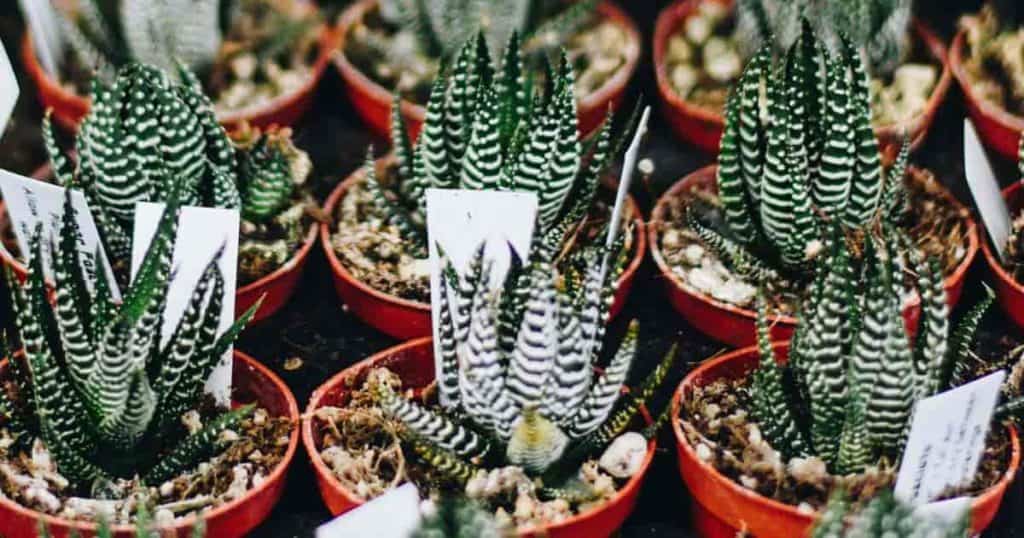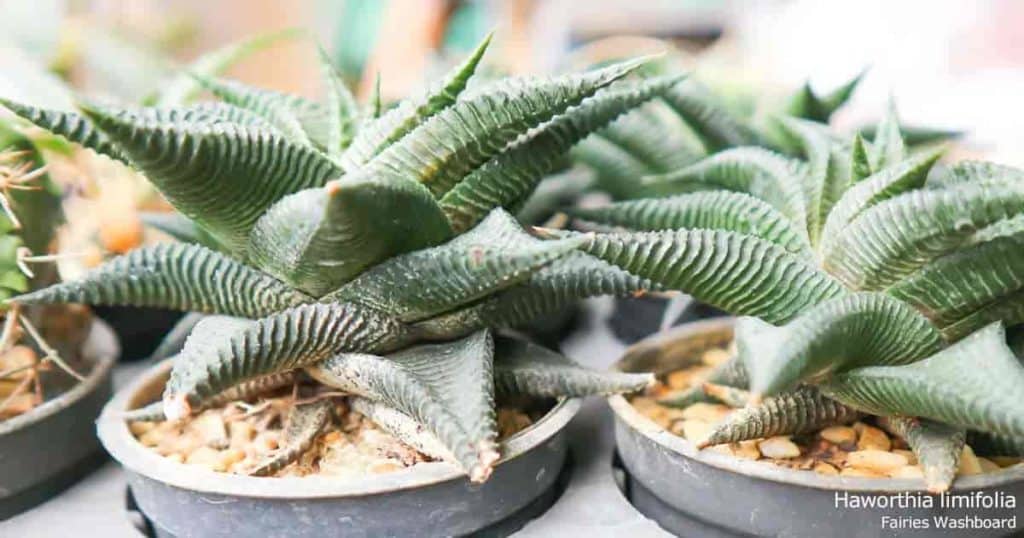A native of South Africa, the Haworthia genus includes over 70 species. The plant was named after British botanist Adrian Hardy Haworth.
Succulent Haworthia plants are easy to grow and care for, making them popular houseplants. The Haworthia is a small plant that requires less light than most succulent plants.

Known for their succulent leaves in colored varieties, including shades of green, red, and brown (almost black), the Haworthia leaves range from thick and fat to thin and bristly.
This plant comes in many textures. Some Haworthia species are smooth, while others have lines, stripes, bumps, and dots.
This slow-growing plant grows well in both indirect or direct light (not too intense sun). The white flowers of H. retusa may appear in early summer or late spring.
In short, if you’re looking for a house plant or a new addition to your garden, Haworthias makes a great, beautiful choice.
This happens in both direct sunlight as well as cooler weather. In spring, it will produce tall flower spikes with tiny, greenish-white, tube-shaped flowers.
Some of the Most Popular Haworthia Varieties
With dozens of species, there are many Haworthia types to choose from for your home or garden. You’ll find Haworthia varieties in the gardening section of grocery stores, home stores, and gardening centers.
If you’re shopping for rare Haworthia types, they are usually available in succulent plant nurseries.
Although they’re primarily houseplants in warm climates and during the frost-free period in cold climates, they can be included in the garden decor.
Haworthia succulents are generally free of most pests. The one exception is mealybugs, which can be a common problem but easily resolved by physical removal or with standard houseplant insecticides.
In this section, we’ll introduce you to the most popular type of haworthia to grow and collect.
Haworthia Cooperi

The Haworthia Cooperi is also commonly known as Bristle Haworthia, Cooper’s Haworthia, Pussy Foot, and Window Haworthia.
It is a slow-growing, densely clustered succulent with cylindrical leaves long enough to reach the soil’s surface.
The shiny leaves grow out from the stem in a rosette pattern. If you hold the plant up to a light, you can see through its transparent leaves.
The Haworthia Cooperi grows up to 2″ inches long, its rosettes up to 3.2″ inches in diameter, and its leaves up to 1.8″ inches long and 0.5″ inches wide. Drainage holes in the planter are beneficial. This allows excess water to drain off easily.
It blooms in the summer and spring, producing pinkish-white flowers with veins with colors ranging from green to brown.
Haworthia Fasciata

Commonly known as the Zebra Plant or Zebra Haworthia, Haworthia Fasciata is its scientific name. This variety of Haworthia stands out for its white horizontal stripes reminiscent of a zebra on its green outer surface.
The Haworthia Fasciata is a low-growing succulent that grows to a height of 4 to 8 inches. Its leaves have a triangular shape with white flowers that usually bloom in summer.
It’s not cold hardy, so if you live in an area where temperatures drop below 30°F, it’s best to keep it as an indoor plant.
Haworthia Attenuata

Like Haworthia Fasciata, Haworthia Attenuata is known as the Zebra Plant. Although they look similar, you can distinguish Haworthia Attenuata from Haworthia Fasciata by its tubercles (warty growths).
Try to include aquarium gravel, sand, perlite, and pumice to enhance drainage. You should also apply organic materials to the mix,
The Haworthia Attenuata is famous for its striking white and green appearance. It’s a low-growing stemless plant notable for its pearly white warts covering its dark-green leaves. This is one of the most commonly cultivated species of the Haworthia plant.
They grow up to 6″ inches tall and up to 5″ inches in diameter. They bloom in the spring and summer, producing bell-shaped pale lavender flowers.
Often though, root rot does not necessarily mean the plant will be lost. If the plant looks unhealthy, unpot it and inspect the roots. Start new plants from offsets.
Haworthia Cymbiformis

Cymbiformis means “boat-shaped” in Latin, and the Haworthia Cymbiformis‘ curved leaves do the name justice.
The plant is also commonly referred to as Boat-formed Haworthia, Cathedral Window Haworthia, Windowed Boats, Window Boats, and Window Haworthia.
It is a hard plant to kill and the easiest Haworthia species to cultivate, making it a great indoor plant for beginners.
To do this, you can use perlite, pumice, and gravel. Fertilize during the growing season with a balanced cactus fertilizer.
The plant does well in low light conditions because the tips of its leaves have fine lines that allow sunlight into the leaf interior.
The Haworthia Cymbiformis has tubular white to pale pink flowers that bloom in the mid-spring to early summer.
Haworthia Limifolia

These charming and compact succulents. Haworthia Limifolia is also commonly known as Fairy Washboard and File Leafed Haworthia.
It forms a rosette of triangular light to very dark green or brownish-green leaves with distinct ridges.
They rarely grow more than 4″ inches long and up to 1″ inch wide at the base. They make a great addition to a desk or window sill. Use a well-drained potting mix for planting this species.
The plant does not welcome the cold and does best in warm, dry climates with bright light, although it can grow in partial shade outdoors.
If you live in a cooler region, Haworthia Limifolia makes an excellent indoor plant. Be sure to place it near a window so it can get plenty of sunlight.
The plant has understated flowers that bloom in the summer from a 14-inch stem growing in the rosette center.
Haworthia Truncata

This small succulent plant species is also known as the Horse’s Teeth. Truncata in Haworthia Truncata refers to the plant’s top part of the plant’s leaves that appear to be truncated.
The plant’s leaves are unique gray or gray-green with warty surfaces and an almost rectangular cross-section.
These plants grow underground, with only the leaves making an appearance above the fresh soil. It grows to a height of between 3” and 5” inches. The Haworthia Truncata typically blooms in summer. Its flowers have greenish-white petals.
Haworthia Retusa

Often referred to as the Star Cactus or the Window Succulent, the Haworthia Retusa is a slow-growing succulent with a short rosette of translucent triangular leaves.
These tiny plants are low maintenance and are a common addition to cactus gardens and window sills.
It grows up to 3″ inches tall and 6″ inches wide. The plant blooms in the late spring and early summer from a tall flower stalk in the middle of the rosette. These stalks grow to a height of up to 20″-inches with small white tubular flowers.
Haworthia Reinwardtii

The Haworthia Reinwardtii makes an excellent indoor plant or a unique addition to a succulent garden.
The plant is commonly referred to as a Zebra Wart because of its white-spotted leaves. Its leaves grow in a spiral pattern and are large at the bottom and pointy at the top.
The rosettes grow up to 8 inches tall, but you’ll often find that they don’t grow more than a few inches.
When the plant blooms in the spring, it produces tubular-shaped white-pink flowers that grow in clusters. They thrive with a lot of sunshine in rooms that don’t drop below 40°F.
Haworthia Coarctata

One of the few succulents on our list that doesn’t have any names that refer to its shape, the Haworthia Coarctata is a low-growing clumping succulent with dark green leaves and white markings.
It has long stems with curved fleshy leaves that go from pink to purple when stressed by the sun or cold.
The Haworthia Coarctata grows up to 8″ inches tall and 2″ inches wide. It’s small enough to grow in a container and also makes a great addition to a succulent garden.
Its green flowers bloom in the summer. This plant does not thrive in the cold and needs about six hours of bright sunlight daily.
Haworthia Pumila

You’ll often hear this slow-growing succulent referred to as the Pearl Plant, Miniature Aloe, or Tear of Angels.
The plant’s leaves form attractive rosettes with triangular leaves. The rosettes grow up to 10″ inches tall and 6″ inches wide.
The Haworthia Pumila takes many years to reach maturity, and it can live as many as 40 years with proper care.
Its large, waxy brownish-white flowers bloom in the summer. The plant does best in semi-shady conditions, making a window sill a great choice.
